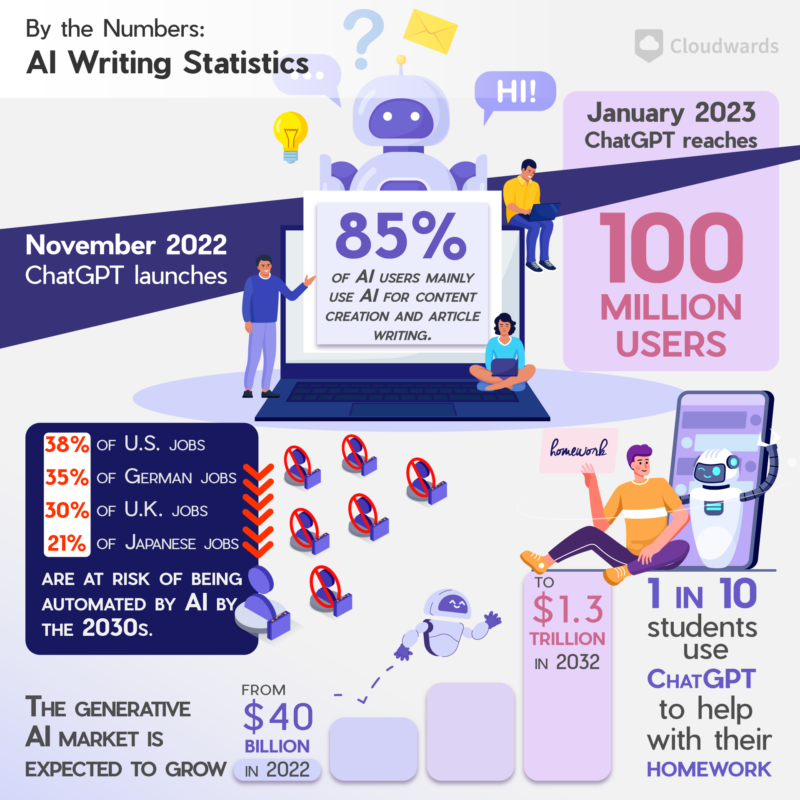50 AI Writing Statistics, Trends & Facts for 2025: Is AI Coming for Your Job?
As a professional, the dreaded thought that a computer or machine might someday replace your job must have crossed your mind. However, while it’s true that some jobs will be taken up by AI writing tools, it’s impossible to completely eliminate the human touch. These 50 AI writing statistics offer a glimpse of your job security.
Key AI Writing Statistics: Editors’ Choices
- ChatGPT reached 100 million monthly active users in January 2023, just two months after its official launch.1
- The global market value for AI is expected to reach $267 billion by 2027.2
- Over 85% of AI users say that they mainly use the technology for content creation and article writing.12
- As many as 85 million jobs will be eliminated by AI and 97 million new ones will be created by 2025.4
AI writing statistics show that AI writing has become commonplace in many industries. With ChatGPT having taken the world by storm just a few months after launching, AI writing software continues to gain popularity and applicability. Workers and job seekers need to upskill and reskill to remain relevant and employable in the job market.
AI writing first appeared on the online writing scene in 2007 within StatSheet,5 used for creating content related to sports statistics. In 2009, Grammarly launched as a more sophisticated writing assistant to detect and correct common grammar mistakes.6 In 2023, we saw the rise of large language models (LLMs), with ChatGPT, Claude, Bard and more.
In this article, we’ve compiled a list of 50 AI writing statistics that show how AI writing software is revolutionizing the world.
AI Writing Statistics: Artificial Intelligence & Content Creation

AI writing tools have made it easier to research, compile and write content. However, content created with AI is not always reliable or truthful.
Additionally, as beneficial as AI writing software may be, it shouldn’t be used to generate content merely for search engine rankings; that goes against the Google Search Liaison guidelines7 and will lead to your content being marked as spam.
- Grammarly was the first sophisticated AI writing assistant software, launched in 2009.6
- OpenAI launched GPT-3 and ChatGPT in November 2022.8
- Over 85% of AI users surveyed in 2023 say that they mainly use AI for content creation and article writing.12
- The machine translation market size is expected to have a compound annual growth rate (CAGR) of 22.8% and grow to $7.5 billion by 2032.9
- AI users may be unaware that the response to their prompt has been copied from another source. This makes it tricky to determine copyright infringement under current laws.10
- Writing scientific research papers using AI raises ethical concerns of privacy, informed consent, transparency, bias and accountability.11
- Over 54% of consumers in 2023 believe they’ve received undisclosed AI content in the past from a service provider.12
- In 2023, 43% of businesses were concerned that they will become too dependent on AI writing technology.12
AI Adoption & Usage Statistics
More companies are integrating AI technology into their systems, mainly for content creation and process automation. Businesses in some countries — like China and the U.S. — have adopted AI technologies more quickly than others. However, the rise of OpenAI and other widely available, free AI tools is making it easier for businesses in other countries to pick up these tools, too.
- Half of the U.S. population uses voice search on their devices on a daily basis in 2022.13
- In 2022, 77% of businesses have adopted or are exploring AI.14
- Chinese companies are the global leaders in AI adoption, with 58% deploying AI and 30% integrating the technology into their systems in 2022.14
- A quarter of companies have adopted AI in 2022 to compensate for labor shortages.14
- AI is expected to see a 37.3% annual growth rate between 2023 and 2030.15
- Italy was the first country to ban ChatGPT due to privacy concerns. This, however, led to a 400% increase in the use of VPNs in the country.16
Impact of AI Writing on the Job Market
In this next set of AI writing statistics, we focus on the big question: “Will AI take my job?” The answer depends on the industry you’re in and how easy it is to automate what you do in the near future.
In May 2023, AI contributed to over 80 thousand job losses in the U.S. alone.3 Considering that no job is completely safe, it’s essential to reskill and upskill from time to time as changes show up in your industry.
- Labor productivity is expected to increase by 40% through the use of AI technologies.17
- By the 2030s, 38% of U.S. jobs, 35% of German jobs, 30% of U.K. jobs and 21% of Japanese jobs are at risk of being automated by AI.18
- The top emerging professions necessitated by AI are cloud computing, data and artificial intelligence, and content creation.4
- Companies that choose to reskill and upskill their workforce will be the most successful.4
- A total of 23% of authors in 2023 used generative AI as part of their writing process to brainstorm ideas and overcome writer’s block.19
- Of these authors, 54% use ChatGPT, 13% use GPT-4 and 8% use Bard.19
- As many as 85 million jobs will be eliminated by AI and 97 million new ones created by 2025.4
- In 2023, 62% of workers believe that adopting AI in the workplace will have a major general impact on employees over the next 20 years.21
- Of the 62% of workers stated above, only 28% believe that AI will affect them personally in their professional careers.21
- As many as 47% of people think that AI would be better than humans at making hiring decisions and evaluating candidates.21
AI Writing in Education
In the education sector, AI can be used for essay writing, doing homework, compiling academic research papers and more. We cannot ignore that AI writing is forcing the global reevaluation of the role of schools and teachers in students’ education.
Teacher-less schools and school-less education are a possibility, where students can learn from home on their laptops without involving a teacher.
- In 2023, 89% of students used ChatGPT to help with their homework.22
- However, 72% of college students and 34% of educators in 2023 wanted AI writing tools banned from college networks.22
- Almost half of teachers in 2023 believed that using AI writing has had a positive impact on their workload.23
- Among Harvard faculty members, 47% are of the opinion in 2023 that AI will have a negative impact on higher learning.24
- Less than 10% of learning institutions have developed guidelines and policies to govern the use of AI writing, as of September 2023.25
- In 2023, there was still no consistent standard for citing or crediting the original authors of written pieces when using AI writing software.26
- Educators in 2023 mainly use AI writing tools to compile information, plan lessons, conduct online research and prepare classroom materials like tests and assignments.23
Global AI Writing Market Size, AI Usage & Growth Statistics
AI writing assistant software solutions help companies save money. Using AI writing software reduces the number of writers and editors that companies need to hire.
Though AI writing tools charge up to $100 monthly, you can write hundreds of thousands of words using them. As a result, AI in general can help companies save up to $35,000 yearly when implemented correctly.28
- The generative AI market is expected to grow from $40 billion in 2022 to $1.3 trillion in 2032, expanding at a CAGR of 42%.27
- Over 65% of people surveyed in 2023 think that AI-written content is equal to or better than human-written content.12
- Over 81% of marketing experts believe that AI may replace content writers’ jobs in the future.12
- However, 65% of those who’ve adopted AI technology say that inaccuracy is still a major challenge of using AI for content in 2023.12
- By 2030, 45% of total economic gains will be a result of product enhancement enabled by AI. Increased product variety and personal appeal will boost consumer demand.20
- China is expected to be the biggest AI market and account for more than 26% of the global AI market share by 2030.20
AI Content Marketing Statistics
When it comes to marketing, AI writing comes in handy, but must be used with caution to avoid being marked as spam by search engines and customers alike.
Using AI writing to generate digital content will continue to impact SEO and search engine rankings. However, Google and other search engines are working around the clock to ensure that they can identify AI-written content and prioritize content written for human consumption rather than just for ranking on search engines. As AI-generated content becomes more prevalent, the use of AI detector tools is increasing to ensure authenticity and maintain content integrity.
- Over 75% of marketers use AI software in their work, with nearly half of them using it multiple times a week in 2023.12
- As many as 41% of marketers report that using AI has led to higher revenue generation from their email campaigns.29
- In 2023, 30% of marketers are worried that AI will negatively affect search traffic and influence search traffic in the next five years.12
- Over 85% of marketers have already started using AI for article writing.12
- A total of 69% of marketers use ChatGPT in their jobs because it’s been made free to use and widely available by OpenAI.12
- AI is used by 39% of email marketers in 2023 to formulate and send out emails.29
- To write email copy, 10% of email marketing teams say that they use AI content generation tools in 2023.29
AI Writing Tools & Machine Learning Statistics
Natural language processing tools like ChatGPT use GPT-3 and other language processing models called large language models. They use “natural language” generation and processing to comprehend and generate natural human language text.
These complex technologies are fed vast amounts of training data to generate human-like responses that are as accurate as possible (read our ChatGPT Facts for more details).
- GPT-3 uses a Microsoft Azure AI supercomputer, which runs on 10,000 GPUs, 285,000 CPUs and 400 Gbps of network connectivity.30
- GPT-3 was the first large language model, enabling it to perform more complex tasks like solving high school-level math problems and programming.31
- As of 2023, the global AI training dataset market is expected to grow at a CAGR of 21.6% to $9.3 billion by 2031.32
Final Thoughts: Writing AI Statistics
AI writing tools continue to learn and evolve through training data and other means, becoming more sophisticated over time. As GPT-3 and GPT-4 have revolutionized the AI writing landscape, their applicability will continue to expand to more and more industries and professions.
If you’re interested in exploring alternatives, check out the guide we wrote on Claude.ai. Alternatively, if you’re not keen on AI assistance on your device, we have a guide on how to turn off Apple AI.
Have you used AI writing tools in your work before? What did you use the tool for? Were the results satisfactory or were you disappointed? Let us know in the comments below, and as always, thank you for reading.
FAQ: AI Usage Statistics
A total of 23% of authors use generative AI as part of their writing process to brainstorm ideas and deal with writer’s block. Of these authors, 54% use ChatGPT, 13% use GPT-4 and 8% use Bard.[19]
There are AI detector tools designed for this purpose. However, as of 2024, these tools are still highly inaccurate and unreliable[33] and often flag human-written content as AI-generated (false positives) and AI content as human-written (false negatives).
Yes, AI writing can be beneficial because it helps boost productivity by providing a rough draft of text, which humans can then read through to ensure accuracy and a logical flow of ideas.
It’s not likely that AI will eventually replace all writers, as AI writing tools can’t have personal engagement with certain content. However, for more generic written content, there is conversational AI happening already to handle repetitive tasks and even for published articles.
Sources:
- Reuters
- Fortune Business Insights
- Challenger Report
- World Economic Forum
- Anyword
- Grammarly
- Google Search Liaison guidelines
- OpenAI
- Global Market Insights
- Congressional Research Services
- An-Najah University
- Authority Hacker
- Upcity
- IBM Global Adoption Index
- Grand View Research
- AtlasVPN
- Accenture
- PWC UK
- The Authors Guild
- PWC
- Pew Research
- Study.com
- Quizlet
- Harvard Survey
- UNESCO
- NC State University
- Bloomberg Intelligence
- Aithority
- Litmus
- Microsoft News
- Harvard Business Review
- Allied Market Research
- Arxiv.org


